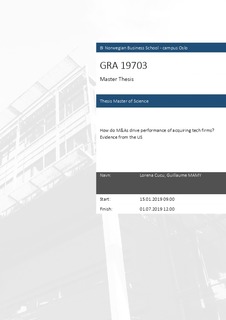How do M&As drive performance of acquiring tech firms? Evidence from the US
Master thesis
Permanent lenke
http://hdl.handle.net/11250/2623431Utgivelsesdato
2019Metadata
Vis full innførselSamlinger
- Master of Science [1621]
Sammendrag
In our study, we aim at understanding what drives acquirer in tech M&As. We examine a sample of
3,813 M&A transactions by US publicly-traded technological firms from 1991 to 2019. Since
bidders1 and deals characteristics vary largely, we test for any significant effect in abnormal
announcement returns. Results suggest that the acquirer’s shareholders gain when engaging in M&As
with a private or subsidiary target, regardless of the size. However, they lose when buying a public
firm, except when the transaction is paid for with cash. Further, a good performer is an acquiringtech
firm that shows financial strength in its liquidity, operational strength in its efficiency, and
substantial growth prospects. In contrast, a poor performer is a bidder that is overvalued, highly
levered and employs a high level of R&D spending. These results are consistent with the signalling,
information asymmetry, size effect and free cash flow hypothesis.
Beskrivelse
Masteroppgave(MSc) in Master of Science in Business, Finance - Handelshøyskolen BI, 2019
